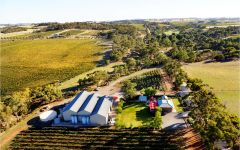Two Hands Hopes and Dreams Red Blend 2016
-
Jeb
Dunnuck -
Robert
Parker



Product Details
Your Rating
Somm Note
Winemaker Notes
Blend: 43% Grenache, 32% Shiraz, 12% Cabernet Sauvignon, 11% Mourvédre, 2% Carignan
Professional Ratings
-
Jeb Dunnuck
A blend of 43% Grenache, 32% Shiraz, 12% Cabernet, 11% Mourvèdre and the rest Carignan, the 2016 Hopes & Dreams Red Blend is a beautifully perfumed, sexy red from Twelftree that's loaded with sweet raspberry and blackberry fruits, incense, spice, white pepper and floral nuances. Ripe, rounded, yet light on its feet and balanced, drink it over the coming 4-6 years.
-
Robert Parker's Wine Advocate
A mashup of 43% Grenache, 32% Shiraz, 12% Cabernet Sauvignon, 11% Mourvèdre and 2% Carignan, the 2016 Hopes and Dreams Red Winemakers Blend might not speak of varietal character, but it delivers a fragrant glass of supple, medium to full-bodied red wine. It hints at cinnamon and pepper on the nose, picks up notes of raspberries and blackberries on the palate, then finishes with a dash of spice and some silky tannins.






The idea for Two Hands was born in September 1999 when founders Michael Twelftree and Richard Mintz sat at a friend’s engagement party and decided it was time to make their own wine and market it on the world stage.
The original aim was, and still is, to make the best possible Shiraz-based wines from prized growing regions throughout Australia. With so much Australian wine being sold around the globe under multi-region labels in a formulaic style, the intention was to break the mold and showcase the diversity of Australian Shiraz by highlighting regional and vineyard characteristics by allowing the fruit to be the primary feature of the wines.
Quality without compromise is central to the Two Hands philosophy, driving all the decisions from fruit and oak selection to packaging and promotion. From the outset, Two Hands set out to be unique and innovative, this approach is reflected in everything from the names of the wines through to, not least, the wines themselves. From small beginnings, the winery has been able to manage its growth organically whilst maintaining an absolute quality focus. Premium fruit is sourced from the finest Shiraz growing regions in Australia, and Two Hands works closely with its estate vineyards and band of growers to ensure the full potential of each vineyard is reached. They handle every parcel of fruit, however small, separately from crushing through to fermentation and oak maturation to ensure complexity and personality in the finished wines.
In its simplest form, it could be said that they squeeze the grapes and put them in a bottle. However, in practice there are many different steps and countless hours involved, from vineyard, through to winemaking, tasting, blending and maturation in order to make consistent, quality wines.

With hundreds of red grape varieties to choose from, winemakers have the freedom to create a virtually endless assortment of blended red wines. In many European regions, strict laws are in place determining the set of varieties that may be used, but in the New World, experimentation is permitted and encouraged resulting in a wide variety of red wine styles. Blending can be utilized to enhance balance or create complexity, lending different layers of flavors and aromas. For example, a red wine blend variety that creates a fruity and full-bodied wine would do well combined with one that is naturally high in acidity and tannins. Sometimes small amounts of a particular variety are added to boost color or aromatics. Blending can take place before or after fermentation, with the latter, more popular option giving more control to the winemaker over the final qualities of the wine.
How to Serve Red Wine
A common piece of advice is to serve red wine at “room temperature,” but this suggestion is imprecise. After all, room temperature in January is likely to be quite different than in August, even considering the possible effect of central heating and air conditioning systems. The proper temperature to aim for is 55° F to 60° F for lighter-bodied reds and 60° F to 65° F for fuller-bodied wines.
How Long Does Red Wine Last?
Once opened and re-corked, a bottle stored in a cool, dark environment (like your fridge) will stay fresh and nicely drinkable for a day or two. There are products available that can extend that period by a couple of days. As for unopened bottles, optimal storage means keeping them on their sides in a moderately humid environment at about 57° F. Red wines stored in this manner will stay good – and possibly improve – for anywhere from one year to multiple decades. Assessing how long to hold on to a bottle is a complicated science. If you are planning long-term storage of your reds, seek the advice of a wine professional.

Historically and presently the most important wine-producing region of Australia, the Barossa Valley is set in the Barossa zone of South Australia, where more than half of the country’s wine is made. Because the climate is very hot and dry, vineyard managers work diligently to ensure grapes reach the perfect levels of phenolic ripeness.
The intense heat is ideal for plush, bold reds, particularly Shiraz on its own or Rhône Blends. Often Shiraz and Cabernet partner up for plump and powerful reds.
While much less prevalent, light-skinned varieties such as Riesling, Viognier or Semillon produce vibrant Barossa Valley whites.
Most of Australia’s largest wine producers are based here and Shiraz plantings date back as far as the 1850s or before. Many of them are dry farmed and bush trained, still offering less than one ton per acre of inky, intense, purple juice.
